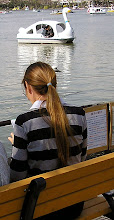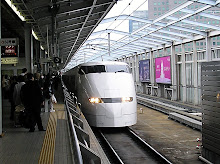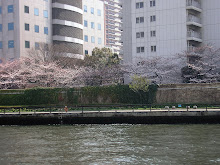by Mr Julie - visited October 2013
Lake Chuzenji/Kegon Falls is a scenic area maybe an hour by bus west o
f Nikko, which is regarded as
THE JAPAN (the same as
Uluru is considered
THE AUSTRALIA or maybe the
Grand Canyon is regarded as
THE USA).
The distance in a straight line from the Mt Nantai place-marker to Nikko station is only 12km - but the road to the lake is over twice this. The windey, steep pass each side of the lake is a great scenic trip in itself.
For some reason I didn't take any pix of the winding mountain passes (maybe on account of the cloudy/misty conditions) - this is a shot early in the trip where we are still in the western outskirts of Nikko. The bus seemed timed to coincide with one of the early daytrip trains from Tokyo and our early weekday bus was absolutely packed out - many of the local area mamasans seemed used to this and handed their bags etc to passengers to nurse. You dudes may be thinking ol'
Mr Julie should give his seat up for these ladies - but at my age I shade them to billy-o (last a quaint ol' Aussie term meaning "
to hell and back").
Okay, I didn't take any shots - but I raided
Google Earth's embedded pix fer a good one - this great pic is from
Hirohuru Shizuya - Panoramio and shows
the road out which for the first 5km or so is actually along a separate route to the road in. This shot doesn't show the awesome views down into the adjacent gorges but the windiness is apparent - I'd love to get my triathlon bike up here and do a down-hill fang.
First stop when we reached the lake was to take the short walk to the right (facing the road from the bus-stop in Chuzenji town) to the top of Kegon Falls. The misty conditions didn't make for great viewing, particularly here at the top of the falls, but.....
.....a quick elevator ride down to the bottom viewpoint was really good value at 530yen. Now I'm not a great fan of spending extra money, but I thought this expenditure was well worth while.
We wondered how good this place looks at times of clear visisibility. Fortunately......
.....
Google images can come up with some good ones. This great January shot is from
Tokyo Topia.
And this nice one shows how the falls actually drains the lake area behind - image from
Japan Unveiled.
Wow, if only we had visited in weather like this.
The area adjacent the elevators at top of the falls had a bunch of touristy outlets selling souvenirs etc - not a bad place to get a coffee at a reasonable price.
From the falls back to town is maybe 5 minutes - the lakeside starts soon after the bus-stop. As seen the mist was pretty hard-core. This is the stop for the ferry lake tour - we decided to give it a miss.
Google images suggests we missed out big time - shot
銭形警部 - panoramio
Chuzenji Onsen is a nice little town. Quite a few hotels, inns and spas plus plenty of restaurants (click image to expand).The tourist walk along the lake-side...........
......is good value, even on misty days.
At the western end of town is a Futarasan shrine. Julie was impressed that there was no entrance charge, unlike the similarly named place and its neighbours back at the world heritage Toshogu site in northern Nikko town.
If you follow the path up through the shrine there is a gate behind which starts the trek up impressively high Mount Nantai. The sign said 6 hours return, and with the time around 1400, we gave it a miss. Nothing to do with my wrecked knees from too much jogging (wrecked knees hate going down steep slopes) or that visibility was limited at the bottom, imagine further up.
Hey, looks like it's worth climbing in good weather, wrecked knees or not. Image by
M.KJ - Panoramio
Nankai is one impressive looking mountain. Apparently an eruption way back helped create the lake. You can see Chuzenji Onsen strung along the far right side -
image japan-guide.com
SUM UP: Despite the misty drizzly conditions I thoroughly enjoyed my day visiting the lake and falls. I have to admit I'd love to go in in fine weather, maybe spend a few nights up there. There is plenty on offer - a great cable car from the highest point of the access road (covered with cloud of course when we passed by in the bus), a 25km lakeside circumferential trek, other places to stay around the lake, two different lake cruises, another waterfall, temples, museums, spas and of course a walk up Mt Nantai (don't want to think about the walk down). At 1200m the lake is high enough to take the edge of Japan's hot/steamy summer weather - which explains why so many foreign embassies put weekend escapes/holiday residences up there. Yumoto Onsen is another seemingly attractive destination about 10km north west of Chuzenji Onsen.
NIKKO
Nikko is a busy tourist town about 2 hours north of Tokyo. As mentioned before, it and the surrounding area are known as
THE JAPAN and as such get a heck of a lot of visitors both foreign and (particularly) domestic.
Access from Tokyo is pretty simple, on the
Tobu Railways line (Julie says to check if your train runs directly to Nikko or if you change trains at Shimoimaichi nearNikko . Don't ask how she knows that this is important) - or for people like us with a
JR rail pass, indirectly via Utsunomiya.
Tobu can sell you a whole rash of combination rail/bus/entry tickets either at their Tokyo offices or in the big tourist information center at their Nikko station. We took advantage at the latter with their 2 day bus pass (2000 yen each) which allowed us to save considerably on several trips the few km north to the Toshogu shrine/Kanmangufuchi Abyss areas and to the wonderful Lake Chuzenji/Kegon Falls.
This is more the less the heart of town - the "town square". The bus-stop shelters are central left and the high-roofed
Tobu railways tourist information center top right. The
Tobu platforms are immediately behind - the
JR station is 250m to the right of frame. There is a string of businesses around the square with quite a few good value budget restaurants. This was shot from the top of our hotel, the
Nikko Park Lodge Tobu Station.
I thought this joint pretty good with a comfy not too small room, quiet (front rooms close to the square may be noisier), reasonable value, a sizable budget
Lion-D'Or supermarket about 3 minutes behind camera and of course quick access to the trains and buses. However I notice Julie's user review on the booking website didn't rate too highly - I think she was unimpressed by no-one seeming to be around on book-in and check-out. But we booked-in and checked-out okay, so who's worrying? (image
Agoda Nikko Park Lodge)
The world-heritage Toshogu shrine area is polarizing - some think it's the bee's knees, other culture-deficits like me are maybe interested in walking around outside but are not too whelmed about the whole thing, particularly paying big money to go inside. And true connoisseurs of Japanese heritage are not impressed by the over the top/ornate nature of many of these buildings. Apparently ol' Iemitsu of the 3rd Tokugawa shogunate who built much of this area in the early 1600s was a mug lair (Aussie for ostentatious show-off). One thing's for sure - present day Japanese think it's worth a look. The area was pretty crowded on a Monday of very dodgy weather.
Julie was disappointed. Apparently this attraction had reasonable entry charges for each place when she first visited in the '90s - she thought 2013's entry fees a real gouge. Additionally the particular Tobu Railways World Heritage Pass which included entry into these buildings was not available at the time - apparently the attractions could not agree on the distribution of funds. So we checked the outsides only.
A good point: access from the station area is easy - it's less than 2km or 5 minutes in the frequent buses (most of which have a final destinations of Lake Chuzenji or further) or a half hour walk thru an interesting mountain town streetscape (turn right up the main road hill from the station square, turn left at the famous Red Bridge - slopes lower-moderate, even the unfit will have no problem).
The Red Bridge (correct name Shinkyo Bridge) was the original entry to the Toshogu area - 300yen allows you to walk on it. We didn't bother - shot this from the bus.
The Toshogu world heritage area is not a bad place to wander for 60 minutes or so, but for me not half as good as the following 40 minutes when we........
.......strolled thru the Kanmangafuchi Abyss area. This is a short distance to the west and down from the opposite side of the main road once leaving the Toshogu world heritage area. Abyss may be a bit strong - it's not exactly a grand canyon type area - but the rapidly flowing whitewater through the narrow valley area was relaxing and attractive. As usual there were cultural attractions - some old temples and about 70 carved stone......
......Bake-jizos which are rumoured to change position between your visits. Crikey!
Our autumn visit saw moderate water flow. This place would probably be really something in spring when the river is swollen by meltwater.
SUM UP: Like at Chuzenji, we only scratched the surface in Nikko town. There is a lot more to do - we didn't go anywhere near the Kirifuri Heights or Kinugawa areas. The latter has onsens and theme parks plus a wide range of accommodation. The former has hiking trails in summer and skiing in winter. On that subject, Google Earth shows a number of ski areas more or less adjacent to Nikko town. The Kirifuri Heights is only a half hour by bus from the station.
Please note that comments are welcome, but we do not check the blog regularly enough to answer questions. Please post your questions on Lonely Planet Thorntree, where you will get the benefit of other posters' wisdom. Alternatively you could post your question on my island and beaches blog forum which gets looked at most days.
 Snow shrouded tea plantation with magnificent backdrop of Mt Fuji.
Snow shrouded tea plantation with magnificent backdrop of Mt Fuji.

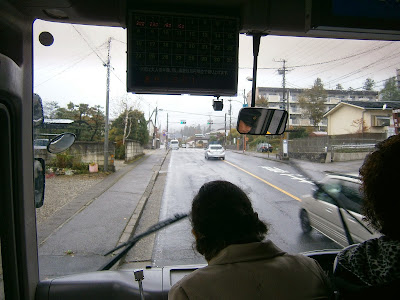
































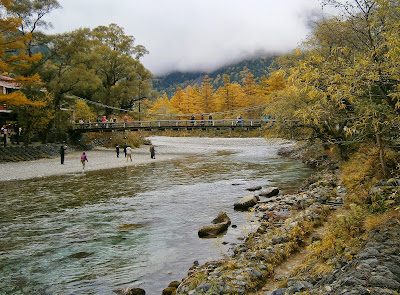
















.jpg)


